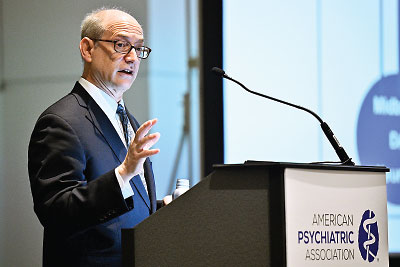Ketamine Pioneer Krystal Receives 2023 Nasrallah Family Award
Abstract
Krystal’s work with ketamine has increased our understanding of the biology of both depression and schizophrenia while also paving the way for a new class of medications.
For over 30 years, John Krystal, M.D., has been following his scientific obsession: a small psychoactive molecule related to MDMA that is used in anesthesia. His efforts at unlocking the secrets of this molecule—ketamine—have led to not only a whole new industry of rapid-acting antidepressants, but also to a deeper understanding of the mechanisms of both depression and schizophrenia.
At APA’s 2023 Annual Meeting, Krystal—the Robert L. McNeil, Jr. Professor of Translational Research at Yale School of Medicine and chief of psychiatry at Yale-New Haven Hospital—received the Nasrallah Family Award for Advances in Psychiatric Neuroscience for his longstanding ketamine research. The Nasrallah Family Award, established in 2020, recognizes distinguished contributions to psychiatric neuroscience that have had a major impact on the field and/or altered the practice of psychiatry.

One of the countless studies John Krystal, M.D., conducted with ketamine showed that the immune-suppressing agent rapamycin can extend ketamine’s transient antidepressant effects, suggesting brain immune cells known as microglia may be involved in determining how long ketamine improves mood symptoms.
At his award lecture, Krystal went back to the late 1980s, when many scientists began to question whether the pathology of schizophrenia is rooted in the frontal cortex and NMDA receptors instead of the midbrain (which is rich in dopamine receptors). Krystal decided to test an idea and provided a single subanesthetic dose of ketamine—an NMDA receptor blocker—to some healthy volunteers. And that single dose elicited transient positive and negative symptoms seen in schizophrenia.
Further work showed that ketamine had this ability to activate some neural circuits involved in working memory, but also surprisingly impeded other circuits from shutting down so that working memory can operate efficiently. “In short, people are generating more signal but can’t suppress the noise.”
Those early studies would pave the way for a range of promising new schizophrenia therapies (none approved yet), of which Krystal has had some involvement. But his focus shifted in 1995 following some interesting work he did with then Yale colleague Dennis Charney, M.D. They had given special drinks to healthy volunteers that depleted their monoamine levels (which make neurotransmitters such as serotonin) but found none of them developed any depressive symptoms. “That led us to think, what if depression is also a defect of the frontal cortex?”
The researchers recruited a small group of people with depression and gave them a single dose of intravenous ketamine. After a few hours, they began reporting feeling a little lighter and happier, and by 24 hours, about 40% had met the criteria for depression remission.
After that, much of the story is known to those in the field of psychiatry. Janssen’s ketamine nasal spray received FDA approval in 2019, and ketamine clinics are available across the country. Meanwhile, ketamine itself continues to be studied for numerous psychiatric disorders, including bipolar disorder, posttraumatic stress disorder, and obsessive-compulsive disorder.
For Krystal, the next pursuit was understanding how ketamine works. Another Yale colleague, Ronald Duman, M.D., made one of the initial discoveries in 2010 with the report that ketamine can encourage neurons to produce tiny spines called dendrites, which can form new connections, or synapses, with neighboring neurons. The synapse proliferation begins many hours after treatment and peaks after one day, at which point the connections slowly dissolve.
What this means is that the growth of these synapses is not necessary to initiate the antidepressant response, but their stability affects how long the response is maintained, he said. Some recent research of his has found that combining ketamine with rapamycin, a drug that suppresses the activity of cells called microglia that chew up neurons, can extend the average antidepressant duration of ketamine for up to two weeks as opposed to a few days. He noted that other groups have used the synapse formation window to provide psychotherapy since individuals are in a state more conducive to changing their mindset.
“The story of how ketamine works is still evolving,” Krystal said, noting that the recent discovery implicating microglia points to inflammation also being involved in the antidepressant process. There are still a great many discoveries waiting, and Krystal is still speeding ahead on his journey. ■



